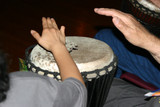Need A Better Sounding Cymbal? Check Your Drumsticks!
That whole “stupid” stereotype that surrounds a drummer is baffling, especially considering all of the effort a drummer puts into play drums, as well as selecting all the right equipment to make a rhythm come alive. To the untrained, non-drummer ear, the nuances in sound, tone and decay from drums and cymbals can be easily written off, but, we know that there is no mistaking the sound of a set of drums for jazz music compared to those played in a metal band. The drums in those drum sets are, of course, a basis for the tone, but it is the cymbals that are perhaps the most genre- and emotion-defining sounds we hear. Still, even a cymbal needs the right tool to help coax out its best sound, and choosing the right drum sticks for your cymbals is as complicated as any other aspect of drumming… and just as much fun.
If you are a drummer, or have ever been into a music store or shopped online for drumsticks, you know that there are more drumsticks than there are drums or drummers in the world. The display racks that contain drum sticks almost cry with the weight of possibilities each style and size of drumstick brings to the beat. You can always go with a “trial and error” method of discovery for the perfect, and YOUR perfect drumstick for your particular cymbals, but, we thought a quick guide could at least steer you in a less demanding direction.
To get loud, choose a drumstick with a fat, barrel-shaped tip. These are great for anyone who plays drums in a marching band, and on stage in a band with a pounding beat that just won’t stop. For cymbals, the sound is loud, but they can also take away some of the inherent sound of the instruments.
For more balance, the tip should be more oval or shaped like a tear drop. These drumsticks work well in a studio, or up on a stage, and for a variety of different styles of music, the various cymbals available, or, even a custom cymbal setup on your own drum set.
A bold, full sound for most rock performances might best be delivered with a drumstick that has a mushroom or umbrella shape to the tip. These have a slightly wider base than a tear drop tip drumstick, giving them a little more of a bounce and increasing the power of each hit.
When it has to be bright, your best bet is a ball-shaped tip for your stick. These drumsticks perfectly draw out the smooth, jazzy sound of any cymbal, with a crisp feel and great vibe, overall.
In terms of picking the right drum sticks for your cymbals, the shape and material of the tip matter just as much as the weight and taper of the drumstick itself. There is such a science in the creation and manufacturing of the different cymbals that we play, no matter what style of music, that it only makes sense that even the slightest variation in the shape of the tip can change your entire sound… and we didn’t even start on the nylon vs. wood tip debate!
To all the drummers who get put in the corner (or back of the stage) as “merely” a time-keeper, remember that without your innate sense of rhythm and attention to the overall sound of your drums and cymbals, music for the rest of the world would all have the same rhythmic tone and timbre. Drummers shape our music more than through a steady beat, and drummers highlight a song in a way no other instrument really can. Sometimes, it is the study of polyphonic harmonies that gets the mood across, other times, it is the crescendo leading up to the crash of a cymbal. But, once in a while, that definition can come from something as simple as the tip of your drumstick.
Recent Posts
-
Incorporating the Thumb Piano into Modern Music Production
Introduction to the Thumb Piano The thumb piano, also known as the Kalimba or Mbira, is a small …15th Apr 2024 -
The Top 5 Djembes for Beginners: A Buyer's Guide
What is a Djembe? A Djembe is a type of drum originating from West Africa, traditionally made from …13th Apr 2024 -
Hand Drums 101: Techniques and Tips for Beginners
Introduction to Hand Drums Hand drums come in various shapes and sizes and are played by hand rath …1st Apr 2024



